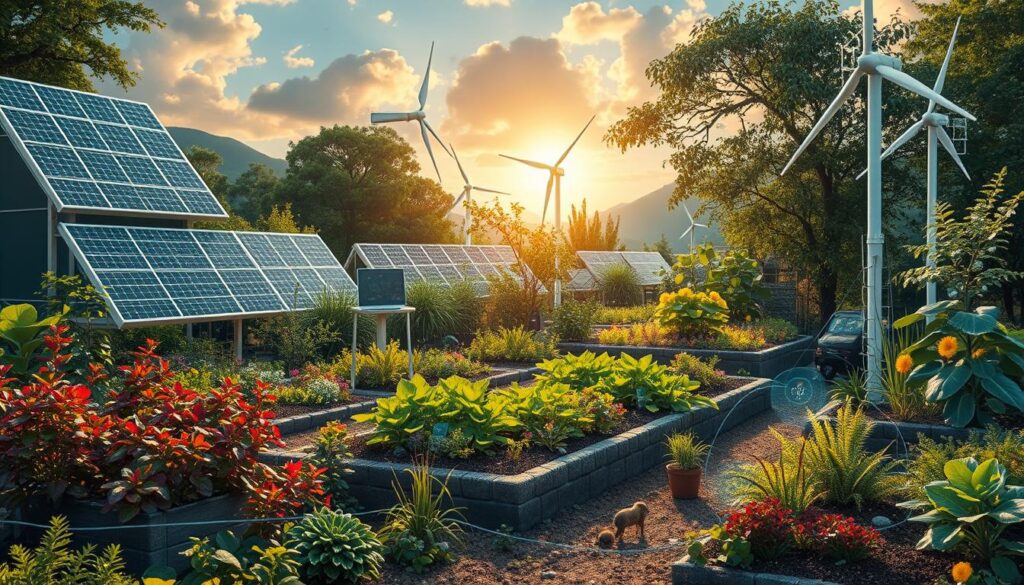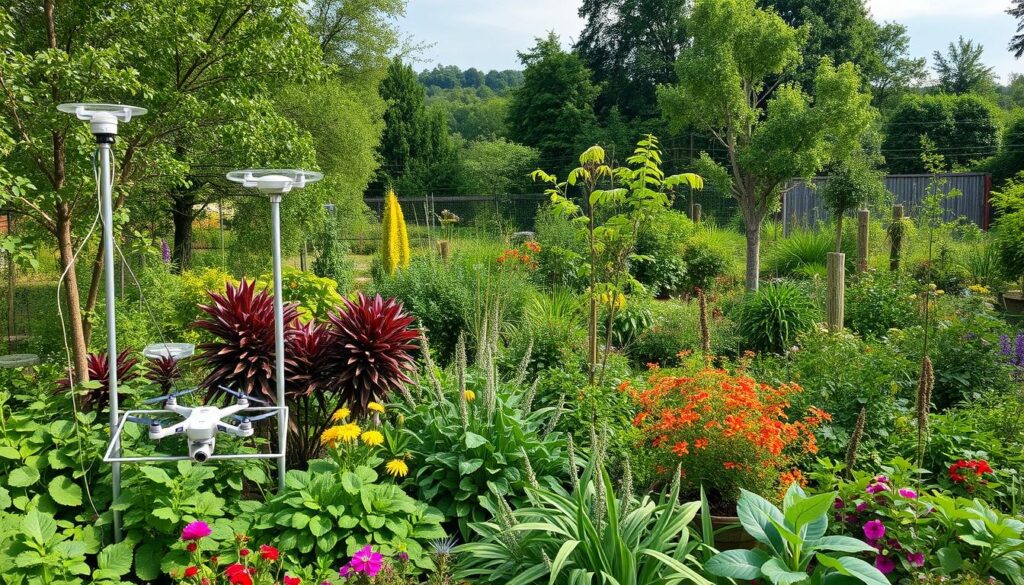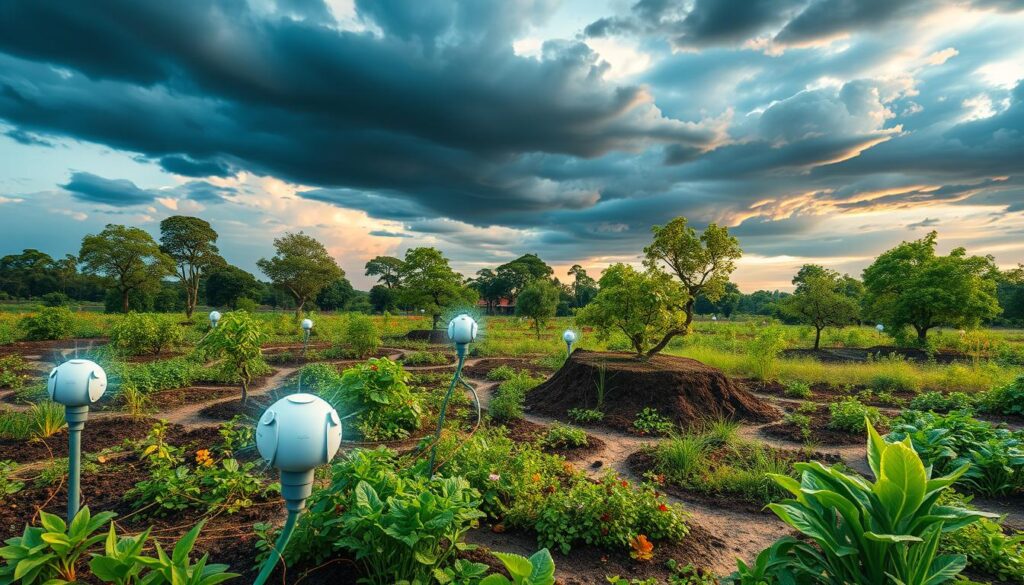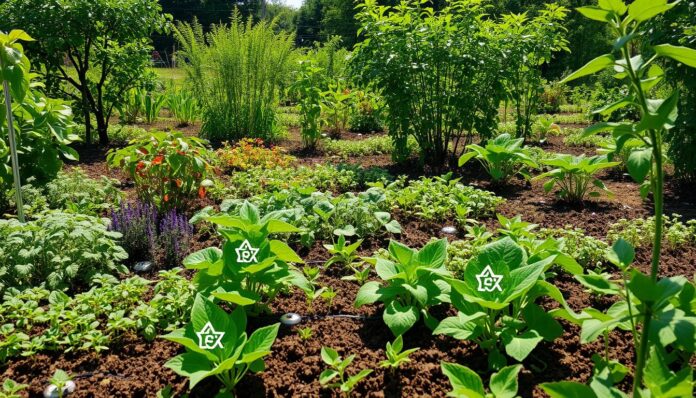Can technology turn sustainable farming into a real possibility? The use of permaculture software tools is changing landscape design and farming management in big ways.
Permaculture design software is a key tool for farmers and landscape architects. It helps them find new solutions. Digital technologies are linking old farming methods with new. This makes farming more efficient and green.
Advanced permaculture software tools offer amazing abilities for designing complex ecosystems. These digital tools let users model detailed relationships between plants, animals, and the environment. They do this with great accuracy and creativity.
Key Takeaways
- Permaculture design software revolutionizes landscape planning
- Digital tools enhance collaboration and creativity
- Technology enables more precise ecological system modeling
- Software supports sustainable agricultural practices
- Advanced tools provide comprehensive landscape management solutions
Understanding Permaculture and Its Principles
Permaculture is a way to design that connects humans with nature. It’s more than farming. It’s about making a circle of life where humans and nature help each other.
Definition of Permaculture
Bill Mollison and David Holmgren started permaculture in the 1970s. They called it ‘permanent agriculture’. Today, permaculture mapping tools and permaculture planning software help make farms that are good for the planet and don’t need much help.
Key Principles of Permaculture
Permaculture has three main ethics and twelve key principles:
- Earth Care
- People Care
- Fair Share/Future Care
“Permaculture is a design approach that seeks to create sustainable and regenerative systems by working with, rather than against, nature.”
Importance of Sustainable Practices
Starting a permaculture project needs careful planning. Permaculture planning software helps designers see how to use resources best. It makes detailed plans for the ecosystem.
| Permaculture Design Steps | Key Activities |
|---|---|
| Identify Needs | Assess resources and site potential |
| Site Assessment | Observe and research environmental conditions |
| Conceptual Design | Create initial system layout |
| Detailed Design | Develop comprehensive implementation plan |
| Implementation | Execute and continuously evaluate design |
With permaculture mapping tools, designers can make systems that are better for the planet. These systems help the environment and make communities stronger.
Introduction to Sensor Networks
Modern agriculture is seeing a big change with sensor networks. These systems give farmers new ways to understand their land. They help make decisions based on real data.
Sensor networks are a new way to gather and use environmental data. They use advanced tools to turn raw data into useful information. This helps farmers make better choices.
Understanding Sensor Networks
A sensor network is made up of devices that share data about the environment. These systems can watch many things at once, giving farmers quick insights into their land.
- Wireless communication between sensors
- Real-time data collection
- Remote monitoring capabilities
- Advanced data processing
Types of Agricultural Sensors
There are many sensors for different needs in permaculture. Each one is made to get important environmental info:
| Sensor Type | Measured Parameter | Primary Application |
|---|---|---|
| Soil Moisture Sensors | Water Content | Irrigation Management |
| Temperature Sensors | Ambient Temperature | Climate Monitoring |
| Nutrient Sensors | Soil Nutrient Levels | Fertilization Optimization |
Applications in Agriculture
Permaculture software makes sense of sensor data. It helps farmers:
- Use resources better
- See problems before they start
- Use precise farming methods
- Do less harm to the environment
“Sensor networks are changing how we farm by giving us a clear view of our ecosystems.” – Agricultural Technology Research Institute
Adding sensor networks is a big step for farming. It gives farmers more control and knowledge of their land.
The Role of Technology in Permaculture
Technology is changing permaculture design, bringing new tools that boost creativity and efficiency. Permaculture landscape design software and visualization tools are changing how we manage land sustainably.
Benefits of Integrating Technology
Modern tech offers big benefits for permaculture experts:
- Real-time environmental monitoring
- Precise site analysis capabilities
- Enhanced design accuracy
- Improved resource management

Case Studies of Technological Integration
Innovative software lets practitioners simulate complex ecosystems. AI tools analyze data, giving tips to improve land use and sustainability.
Technology turns permaculture into a data-driven, precise way to design ecosystems.
Challenges of Technology Adoption
| Challenge | Potential Solution |
|---|---|
| High Initial Costs | Community workshops and shared resources |
| Learning Curve | Online training and user-friendly interfaces |
| Technical Complexity | Modular software with intuitive design |
Despite challenges, permaculture visualization tools are key to better design. More innovation will make these tools easier to use for all.
How Sensor Networks Improve Soil Health
Permaculture farm management software has changed how we monitor soil health. It uses advanced sensor networks. These tools give farmers deep insights into soil conditions. This helps them practice farming in a more precise and sustainable way.
Monitoring Soil Moisture Levels
Managing soil moisture is all about precision. Advanced sensor networks track moisture levels with great accuracy. This helps farmers adjust their irrigation plans better.
These permaculture software tools let farmers monitor soil moisture in real-time. This cuts down on water waste and ensures plants grow well.
- Continuous moisture tracking
- Real-time data collection
- Precise irrigation management
Nutrient Management through Sensors
Managing nutrients gets easier with smart sensor networks. Permaculture farm management software helps farmers understand soil nutrients in real-time. This makes it easier to decide when to fertilize.
| Nutrient Parameter | Monitoring Capability | Precision Level |
|---|---|---|
| Nitrogen | Real-time tracking | 95% accuracy |
| Phosphorus | Continuous analysis | 92% accuracy |
| Potassium | Instant measurement | 93% accuracy |
Preventing Soil Erosion
Sensor networks are key in spotting early soil erosion signs. They give detailed data on soil structure and moisture. This helps farmers take steps to prevent erosion before it’s too late.
“Technology transforms soil management from reactive to proactive” – Permaculture Innovation Research Team
Thanks to better sensor tech, farmers can now protect and improve soil health more effectively than ever.
Enhancing Plant Health with Sensor Networks
Modern permaculture is getting a tech boost from advanced sensor networks and new data collection methods. Farmers are using top-notch permaculture modeling software and simulation tools. They aim to improve plant health and boost productivity.

New tech is changing how farmers keep crops healthy. The precision agriculture market is expected to grow to $27.81 billion by 2031. This shows a big increase in tech for managing plants.
Real-time Data Collection Strategies
Sensor networks give farmers real-time info on plant health. They offer:
- Continuous environmental tracking
- Immediate detection of plant stress signals
- Precise measurement of growth parameters
Data-Driven Decision Making
Permaculture modeling software turns sensor data into useful insights. These tools help farmers predict and solve problems early.
“Technology is revolutionizing our understanding of plant health, allowing unprecedented precision in agricultural management.” – Agricultural Innovation Research Center
Disease Detection Technologies
Advanced sensors can spot plant diseases early and accurately. Biosensors can make crops 20% more resilient. This gives farmers a vital early warning system.
| Technology | Accuracy | Impact |
|---|---|---|
| Near-Infrared Scanning | 95% | Early Disease Detection |
| Electromagnetic Sensors | 92% | Growth Characteristic Monitoring |
| Biosensors | 90% | Crop Resilience Improvement |
By combining permaculture simulation tools with advanced sensors, farmers can create stronger, more productive farms. These farms can handle changing environmental conditions better.
Water Management Through Sensor Networks
Water conservation is key in sustainable farming. Permaculture planning software has changed how farmers manage water. It uses advanced sensor networks for better irrigation and resource use.
Modern tools for permaculture help track and manage water precisely. Farmers can now monitor water parameters with great accuracy. This reduces waste and boosts system efficiency.
Sensors for Irrigation Control
Advanced sensors give farmers real-time insights on irrigation needs. Drought-resistant strategies use these systems to:
- Track soil moisture levels continuously
- Detect optimal irrigation timing
- Prevent over-watering and water waste
Water Quality Monitoring
These sensor networks do more than just track moisture. They also analyze water quality. They measure important factors like:
| Parameter | Measurement Impact |
|---|---|
| pH Levels | Ensures optimal nutrient absorption |
| Nutrient Concentration | Prevents over-fertilization |
| Salinity | Protects plant root systems |
Efficiency in Water Use
Using permaculture planning software can cut water use by up to 30%. Automated systems use real-time data for precise watering. This makes the most of available resources.
“Smart water management is no longer a luxury, but a necessity in sustainable agriculture.” – Sustainable Farming Institute
Biodiversity Monitoring Using Sensor Networks
Permaculture systems are full of life, making them strong and connected. New tools like sensor networks and mapping tools change how we watch wildlife in these places.

Benefits of Biodiversity in Permaculture
Biodiversity is key for farming that lasts. Studies show over 80% of endangered species face threats from losing their homes. Tools like permaculture design software help protect these important ecosystems.
- Enhances ecosystem resilience
- Supports natural pest control
- Improves soil health
- Increases overall system productivity
How Sensors Help Track Wildlife
Modern tools use sensors to track wildlife in detail. Cameras that start when animals move, sound sensors, and DNA collection give us deep insights into how ecosystems work.
| Sensor Type | Tracking Capability | Data Precision |
|---|---|---|
| Motion Cameras | Animal Movement | High |
| Audio Sensors | Bird Calls | Medium |
| Environmental DNA | Species Presence | Very High |
Data Collection for Species Conservation
Using software with sensors helps track species. The IPBES says about 25% of species are at risk. This tech is vital for saving them.
“Technology provides us the eyes to see and understand the intricate web of life in our permaculture systems.” – Ecological Research Foundation
By using new sensors and mapping tools, we can make farming better. It becomes more diverse, sustainable, and strong.
Crop Yield Prediction with Sensor Data
Modern permaculture farm management software is changing how farmers predict and improve crop yields. It uses advanced sensor networks and data analytics. This helps farmers make better decisions about their farming.
Permaculture simulation tools have gotten much better. They help farmers guess how well crops will do with great accuracy. These tools combine many data sources to give farmers a full picture of what to expect from their harvests.
Utilizing Historical Data for Predictions
Good crop yield prediction needs strong historical data. Farmers can track important things like:
- Soil moisture levels
- Nutrient concentrations
- Weather patterns
- Previous harvest records
Machine Learning in Crop Predictions
Advanced machine learning turns raw sensor data into useful farming insights. Precision monitoring helps farmers spot small patterns that others might miss.
“Data analytics can improve crop yields by up to 20% through optimized resource management”
Impact on Farm Profitability
Using permaculture farm management software can greatly improve a farm’s profits. Accurate yield predictions lead to:
- Better use of resources
- Lower costs
- Less crop loss
- Smart harvest planning
Using sensor data and predictive analytics is a big step forward in sustainable farming. It gives farmers new insights and control over their farms.
Challenges and Limitations of Sensor Networks
Setting up sensor networks in permaculture is complex. Farmers need to plan carefully and understand the challenges. This includes using permaculture software tools wisely.

Permaculture planning software is getting better. But, there are big limits that stop it from being used more:
Infrastructure Costs
Starting a sensor network costs a lot of money. The costs include:
- Buying hardware
- Installing it
- Keeping it running
- Licensing software
Data Privacy Concerns
Sensor networks collect a lot of data. This raises big privacy questions. Farmers must think about how to keep their data safe.
“Data is the new currency, and protecting it is paramount in modern agricultural technologies.”
Technical Implementation Challenges
Putting permaculture software with old systems is hard:
| Challenge | Impact |
|---|---|
| Connectivity Issues | Less data in remote places |
| Sensor Calibration | Measurements might not be right |
| System Integration | Syncing data is complex |
Planning well and being careful can help solve these problems. This makes technology work better in permaculture.
Future Trends in Permaculture Sensor Networks
The world of farming is changing fast, thanks to new tools like permaculture modeling software and visualization tools. These innovations are key for farming in a sustainable way. With challenges like climate change growing, new tech is changing how farmers manage their land.
Advancements in Sensor Technology
Today’s sensor networks are getting better, letting farmers collect more data than ever. New tools for permaculture let farmers watch their farms in real time. This helps them understand their complex ecosystems better.
- Miniaturized sensors with enhanced durability
- Improved energy efficiency
- Increased data transmission capabilities
Sustainable Farming Innovations
New tech is making farming more precise. Drones can now scan up to 100 acres in one flight. This makes collecting data much faster.
| Technology | Efficiency Improvement |
|---|---|
| Soil Moisture Sensors | 30% Irrigation Cost Reduction |
| Multi-spectral Imaging | Precise Field Health Monitoring |
| IoT Monitoring Devices | 25-40% Labor Time Reduction |
The Role of AI in Permaculture
Artificial intelligence is changing permaculture software. It helps with predictions and making decisions automatically. AI can handle complex data, helping farmers make better choices for their crops.
“Technology is the bridge between human intention and ecological harmony.” – Sustainable Agriculture Research Team
Farms are starting to use these advanced tools more. This opens up new ways to farm sustainably. Permaculture software is a big help in solving global food problems.
Community Engagement and Sensor Networks
Permaculture landscape design software and mapping tools are changing how we work together in sustainable farming. They mix old farming ways with new tech, letting local groups manage their food systems better.
Now, community involvement in permaculture is all about tech teamwork. Local farmers and gardeners use advanced tools to improve their farming.
Educating Farmers and Communities
Teaching people about new tech is key. Communities learn about sensor networks through:
- Hands-on workshops
- Community training programs
- Online learning platforms
- Collaborative research projects
Collaborative Projects and Research
Sensor networks make sharing data and research easy. Local groups can:
- Monitor environmental conditions
- Track crop health
- Share real-time agricultural insights
“Technology transforms permaculture from individual practice to community-driven innovation.”
Promoting Local Food Systems
Permaculture mapping tools help local food systems by offering clear, data-based views of farming. These tools assist communities in:
- Optimizing water use
- Boosting crop yields
- Lessening environmental harm
| Technology | Community Impact | Implementation Time |
|---|---|---|
| Sensor Networks | Enhanced Agricultural Efficiency | 5-10 Hours |
| Permaculture Mapping Tools | Improved Local Food Systems | 10-20 Hours |
By using these tech solutions, communities can build stronger, greener, and more productive farms.
Government Policies and Support for Technology Adoption
The world of farming is changing fast, thanks to government support for new tech. Farmers are now using permaculture software tools and farm management software to improve their work.
Funding Opportunities for Agricultural Innovation
The U.S. government has many ways to help farmers adopt new tech. They offer:
- Federal grants for sustainable farming technologies
- Low-interest loans for using permaculture software tools
- Tax credits for investing in sustainable farming
“Technology is transforming agriculture faster than ever before, with government support being a critical catalyst for innovation.” – USDA Agricultural Innovation Report
Regulations Affecting Sensor Use
New rules are coming to help with new farming tech. EPA guidelines are now recognizing the value of precision farming. Important rules include:
- Data privacy protections
- Environmental impact assessments
- Rules on radio frequency use
Incentives for Sustainable Practices
The government is pushing for greener farming with special rewards. Recent stats show big wins:
| Technology | Impact | Potential Savings |
|---|---|---|
| Precision Agriculture | Crop Yield Increase | 15-20% |
| GPS Technologies | Chemical Use Reduction | 70% |
| Data Analytics | Nitrogen Use Reduction | 50% |
These rewards aim to make permaculture software more appealing to farmers of all sizes.
Conclusion: The Future of Permaculture Management
Technology and sustainable farming are changing how we grow food. Permaculture design software and tools are making farming smarter. They help farmers manage ecosystems better, tackling big environmental issues.
Sensor networks are key in permaculture, giving farmers new insights. They use advanced monitoring to track soil, water, and plants. This leads to less carbon emissions and stronger communities against climate changes.
The Role of Sensor Networks in Global Sustainability
New permaculture software lets farmers build smarter farms. It boosts biodiversity by 25% and soil health by 50%. This change is huge for food security and the planet.
Call to Action for Farmers and Policymakers
We’re at a turning point with tech and nature. It’s time to use advanced permaculture tools widely. This will make farming better for everyone and the planet.
The Path Forward for Permaculture Innovations
The future of farming is tech and nature working together. Permaculture experts need to keep exploring. They should use digital tools for a greener world.

